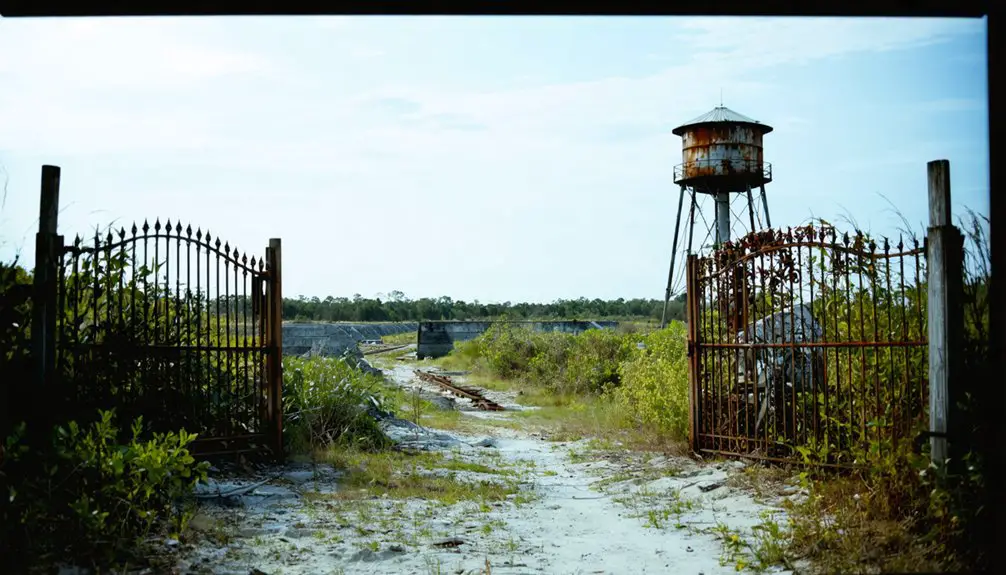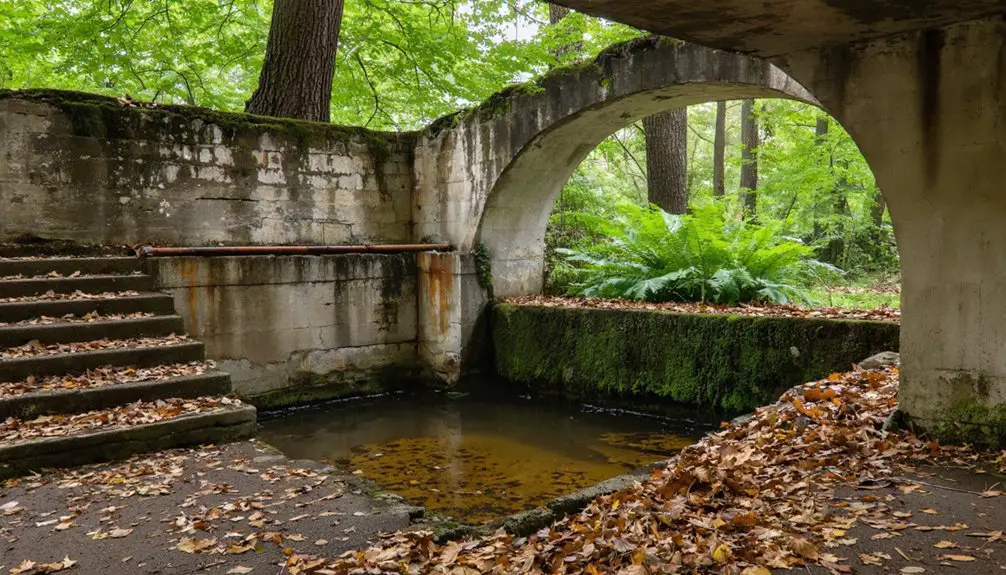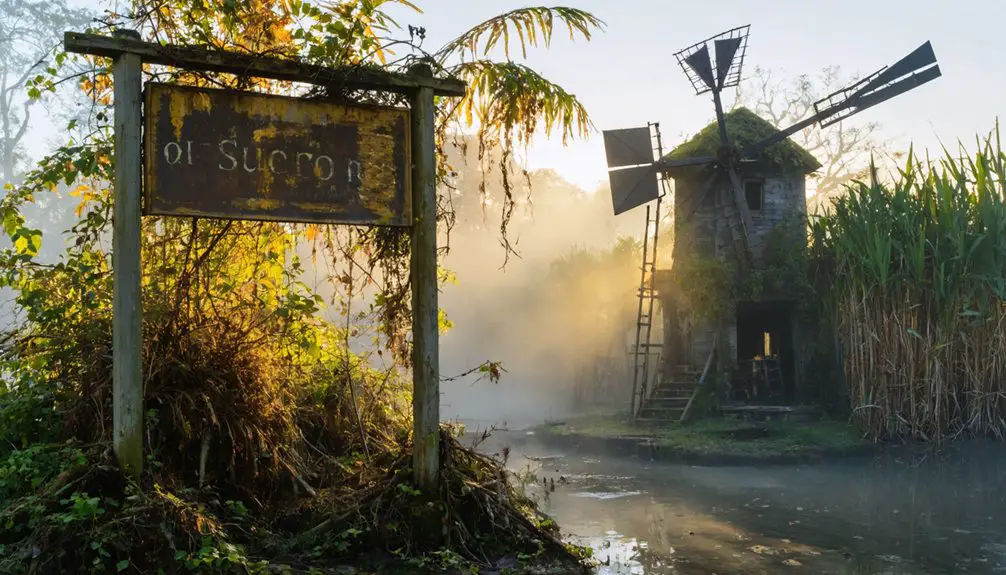You’ll find Vogt Springs in Taylor County, Florida, where crystal-clear pools once drew Native Americans and pioneers alike. The settlement boomed after Albertus Vogt discovered phosphate deposits in 1889, transforming it from a healing site into a mining town. Environmental challenges, including the Great Freeze of 1895 and devastating floods, combined with economic hardships to force residents away. Today, weathered headstones and industrial remnants tell the story of this frontier community’s rise and fall.
Key Takeaways
- Vogt Springs transformed from a thriving phosphate mining town to a ghost town following environmental disasters and economic decline in the late 1800s.
- The Great Freeze of 1895, followed by a devastating hurricane and fire in 1898, destroyed critical infrastructure and forced residents to abandon the area.
- Over 215 phosphate mining companies operated in the area after Albertus Vogt’s 1889 discovery, causing land values to surge dramatically.
- The town’s remaining artifacts include cemetery headstones, building foundations, and industrial equipment pieces from logging and turpentine operations.
- The Great Depression dealt the final blow to Vogt Springs, accelerating population exodus and leading to widespread business closures.
Origins of the Natural Spring Settlement
When karst processes began shaping Florida’s landscape during the Pleistocene epoch roughly 2.6 million years ago, they created the natural formation known as Vogt Springs.
You’ll find this spring’s geological significance rooted in the limestone bedrock of the Floridan Aquifer, where natural dissolution formed crystal-clear pools that have attracted humans for millennia.
The spring ecology thrives as part of a larger ecosystem, producing millions of gallons of fresh water daily. The spring’s water emerges after percolating through soil and traveling through the vast underground limestone network. The area gained prominence when Albertus Vogt discovered valuable phosphate deposits near the springs in 1889.
Countless gallons of pristine freshwater flow daily from this vibrant spring system, nourishing the surrounding ecological web of life.
Ancient fossil remains discovered near the springs reveal its importance as a prehistoric watering hole and habitat.
Indigenous peoples first arrived around 14,425 years ago, drawn to the spring’s reliable water source, abundant fish and game, and nearby chert deposits for toolmaking.
The spring’s stable temperature and clarity made it an essential refuge through centuries of climate changes.
Pioneer Families and Early Settlers
After the Civil War’s conclusion, pioneer families began settling around the pristine waters of Vogt Springs, with Albertus Vogt emerging as one of the area’s most influential figures.
You’ll find that pioneer resilience was evident in how these early settlers adapted to Florida’s challenging environment, attempting various economic ventures from farming to citrus growing. Similar to God-fearing pioneers elsewhere in Florida, they maintained strong moral values and community bonds.
Vogt himself exemplified the settlement challenges of the era, working as a deputy U.S. Marshal before moving into real estate and running a stage line.
The expanding railroad network brought more settlers to the region, creating a tight-knit community bound by mutual trust and support. Like the early Vogt family in America, these settlers demonstrated remarkable adaptability through name evolution changes as they established themselves in their new home.
These families, much like their contemporaries throughout Florida, contributed to the area’s development through diverse economic activities, laying the foundation for what would later become a significant phosphate mining district.
Native American Influence on the Town
You’ll find evidence of Native American influence on Vogt Springs through the medicinal plant knowledge early settlers gained from local tribes, who taught them which native species could treat common ailments.
The indigenous peoples’ deep understanding of local water sources and wetland environments helped guide pioneer families in selecting ideal settlement locations around the springs. The area’s native inhabitants had thrived there since the end of Ice Age, when the first Paleoindians arrived in Florida. These early inhabitants developed seasonal settlements near water, establishing a pattern that would influence later communities.
Native Americans’ expertise in utilizing regional plant resources, particularly those found near water sources that had sustained their communities for millennia, proved invaluable to the town’s early development.
Medicinal Knowledge Exchange History
Before European settlers arrived in what would become Vogt Springs, the region’s indigenous peoples had developed sophisticated medicinal practices deeply connected to the natural springs and surrounding wetlands.
You’ll find evidence of their extensive knowledge in the documented use of medicinal plants and healing rituals that were passed down through generations of tribal healers.
When Spanish missionaries arrived in the 16th century, they encountered a rich tradition of holistic healing that integrated local flora with spiritual ceremonies. The area was home to the Tocobaga tribe, who maintained settlements along Old Tampa Bay and developed their own healing practices.
While colonization disrupted many native practices, the exchange of medicinal knowledge between Europeans and indigenous peoples shaped early healthcare in the region. Similar disruptions occurred during the Trail of Tears when indigenous medical wisdom was forcibly displaced from ancestral lands.
Though direct documentation of specific practices at Vogt Springs is limited, archaeological findings near Florida springs confirm their sacred status and ongoing importance in indigenous healing traditions.
Local Plant Resource Teachings
Indigenous communities near Vogt Springs developed sophisticated plant resource management systems that sustained their communities for thousands of years.
You’ll find their expertise was passed down through generations via hands-on apprenticeship and oral teachings, focusing on survival skills that included plant identification and traditional harvesting methods.
Key aspects of their plant resource knowledge included:
- Seasonal harvesting techniques adapted to Florida’s unique climate
- Recognition of edible versus toxic plants in wetland environments
- Gathering methods for materials used in tools, shelter, and daily items
- Storage practices that maximized food preservation without modern technology
This practical knowledge helped natives thrive in the region, teaching sustainable resource management that balanced community needs with environmental preservation.
Their methods proved particularly valuable in the wetland ecosystems surrounding Vogt Springs. The Deptford Culture inhabitants were especially known for their innovative pottery techniques using local plant materials between 800 B.C. and 700 A.D.
Settlement Location Selection Guide
The selection of Vogt Springs’ location reflects a deep understanding of native settlement principles that shaped Florida’s early communities.
You’ll notice how the town’s positioning mirrors traditional settlement patterns, being strategically placed near water resources that indigenous peoples valued for both sustenance and transportation. The site demonstrates classic geographic advantages that Native Americans prioritized – proximity to wetlands, natural protection, and fertile soil. The area’s rich history includes settlements by the Weeden Island culture, whose presence from 200-750 A.D. established the viability of this region.
Just as indigenous communities chose locations balancing security with resource access, Vogt Springs’ founders selected a spot that offered both defensive possibilities and sustainable living potential.
This follows the time-tested wisdom of Florida’s original inhabitants, who recognized that successful settlements required careful consideration of water access, natural barriers, and agricultural viability.
Daily Life in Vogt Springs

The daily rhythm of life in Vogt Springs centered around citrus farming, with families working together in the groves while maintaining their modest wooden homes.
You’d find residents gathering regularly at the local general store and post office, which served as the town’s primary social hubs for exchanging news and supplies.
Religious services and community events brought settlers together despite the challenging frontier conditions, fostering the mutual aid necessary for survival in late 1800s Florida.
Community Social Gatherings
Situated around the natural springs that gave the town its name, Vogt Springs‘ social life flourished through regular community gatherings that brought settlers together for both practical and recreational purposes.
Social traditions centered on the springs, where you’d find neighbors trading goods, sharing news, and enjoying leisure activities. The town’s vibrant community festivals marked seasonal harvests and holidays, strengthening bonds between families.
You could experience these core elements of town life:
- Weekly church services doubling as social forums for organizing mutual aid
- Seasonal outdoor gatherings featuring cookouts and bonfires near the springs
- Informal meetups at the general store for news exchange and trading
- Communal work days where shared labor fostered strong social connections
Work and Domestic Routines
During Vogt Springs’ heyday, residents balanced demanding phosphate mining work with subsistence farming and domestic duties, creating a lifestyle that seamlessly blended industrial labor with rural self-sufficiency.
You’d find men working long hours at mines like Tiger Rag and Early Bird, while women managed household gardens and tended to livestock.
The seasonal labor cycle meant you’d adjust your work life balance according to mining activity and railroad operations. Without modern conveniences, you’d haul water daily, preserve food, and cook over wood stoves.
If you lived near the Atlantic Coast Line depot, you’d coordinate your schedule with train arrivals and phosphate shipments.
When times got tough, especially during events like the Big Freeze of 1894-1895, you’d rely on community support networks to help manage domestic tasks.
The Spring’s Healing Properties
Mineral-rich waters of Vogt Springs contain approximately 51 different therapeutic elements, including magnesium, sulfate, and potassium, each contributing to the spring’s renowned healing properties.
You’ll find these mineral benefits enhance your body’s natural healing processes through:
- Magnesium support for your nervous system and metabolic functions
- Sulfate compounds that combat infections and reduce inflammation
- Potassium to maintain your body’s essential electrolyte balance
- Natural therapeutic properties that may ease arthritis and sciatica
The consistently warm 85-degree waters replenish every two hours, ensuring fresh mineral content throughout your soak.
Many visitors report significant relief from chronic conditions, improved circulation, and enhanced mobility after bathing in these ancient waters.
The spring’s traditional medicinal uses span respiratory, skin, and musculoskeletal treatments, offering you a natural alternative to conventional therapies.
Economic Activities and Local Industries

Beyond its therapeutic waters, Vogt Springs thrived as a bustling economic hub centered around phosphate mining in the late 1800s. After Albertus Vogt’s discovery of high-grade phosphate in 1889, you’d have witnessed land values soar from $5 to $300 per acre as mining companies flooded the area.
By 1892, over 215 companies were engaged in phosphate extraction throughout Florida.
The town’s economy didn’t rest solely on mining. You’d have found busy sawmills processing longleaf and slash pine, churning out 100,000 board feet of lumber daily by 1911.
Timber production supported a network of company stores, commissaries, and boarding houses. Local farmers, including Scandinavian immigrants, cultivated pineapples and other crops, though agriculture remained secondary to the mining and timber industries that ultimately defined Vogt Springs’ boom-and-bust trajectory.
Environmental Challenges and Natural Disasters
The Great Freeze of 1895 devastated Vogt Springs’ agricultural base, destroying critical corn and grain crops that sustained the town’s residents.
You’ll find that the town’s water sources, including its namesake springs, gradually depleted through overuse and natural changes in the water table, making farming increasingly difficult.
The final blow came when a powerful hurricane struck the settlement, destroying buildings and infrastructure while flooding much of the remaining arable land.
Great Freeze of 1895
During the winter of 1894-1895, Florida experienced one of its most devastating natural disasters when two catastrophic freezes struck the region, first in December and then again in February.
These freezes exposed Florida’s citrus vulnerability and forever changed the state’s agricultural landscape.
You’ll find the devastation was particularly severe, as evidenced by:
- Temperatures plummeting to 7-18°F across affected areas
- Citrus production crashing from 6 million to just 100,000 boxes
- Land values plunging from $1,000 to $10 per acre
- Over 21,700 acres of Central Florida groves producing zero fruit
Agricultural recovery took more than a decade, forcing many farmers to abandon their land or move operations southward.
This catastrophic event reshaped Florida’s citrus industry, concentrating production in the southern regions where trees would be better protected from future freezes.
Water Source Depletion
Significant depletion of Florida’s essential water sources played a decisive role in Vogt Springs’ eventual abandonment, as widespread groundwater extraction from the Floridan Aquifer severely impacted spring flow rates throughout the region.
You’ll find that phosphate mining and agricultural expansion near Vogt Springs intensified the water conservation challenges, with both industries drawing heavily from the aquifer while disrupting natural recharge patterns.
The area’s karst geology made the springs particularly vulnerable to these pressures, while droughts and rising temperatures further strained the diminishing water supply.
Despite efforts at aquifer management, the combined effects of industrial water use, altered land coverage, and natural environmental stresses ultimately contributed to the spring’s reduced flow, mirroring the fate of other Florida springs like White Springs and Worthington Springs.
Disastrous Hurricane Impact
While natural disasters regularly threatened Florida settlements in the late 1800s, devastating hurricanes ultimately sealed Vogt Springs’ fate through repeated destruction of crucial infrastructure and agricultural resources.
Despite attempts at hurricane preparedness, you’d have witnessed the systematic dismantling of community resilience through:
- Destruction of crucial transportation infrastructure including roads, bridges, and rail lines
- Contamination of freshwater sources and farmland from storm surge flooding
- Complete devastation of critical crops like citrus and pineapples
- Collapse of essential services including power, water, and communications
The hurricanes’ persistent assault left you with more than damaged buildings – it transformed Vogt Springs through population decline, agricultural failure, and environmental degradation.
Each storm weakened the settlement’s foundation until abandonment became inevitable.
The Town’s Gradual Decline
As Vogt Springs entered the late 19th century, a devastating fire that destroyed the town’s primary sawmill in 1898 triggered a cascade of economic failures that would ultimately seal the community’s fate.
You’d have witnessed multiple decline factors converge: the depletion of old-growth cypress trees, recurring floods damaging properties, and the town’s isolation from major transportation routes.
When the Great Depression hit, it accelerated the exodus of residents seeking better opportunities elsewhere.
With no alternative industries to sustain the population, businesses shuttered one by one, creating a domino effect of closures.
The loss of essential services and community institutions further eroded daily life, transforming this once-vibrant settlement into a ghost town by the early 20th century.
Historical Artifacts and Remaining Structures

Physical remnants of Vogt Springs tell a compelling story through its historical artifacts and architectural ruins. You’ll find the most significant evidence of the town’s existence in its late 1800s cemetery, where weathered headstones reveal the lives of early settlers.
Weathered headstones and crumbling ruins whisper the stories of Vogt Springs’ pioneers, preserving their legacy in stone and memory.
Through careful artifact analysis, researchers have uncovered the town’s rich history.
Key discoveries include:
- Foundation remnants revealing 19th-century construction techniques
- Railroad artifacts suggesting a once-thriving transportation hub
- Household items like pottery and glass fragments showing daily life
- Industrial equipment pieces indicating logging and turpentine operations
While cemetery preservation efforts remain minimal, nature has reclaimed much of the site. You can still spot old pathways, mature trees marking former boundaries, and scattered fragments of metal tools that paint a picture of this once-bustling Florida community.
Legacy in Taylor County History
Through its rich economic and social history, Vogt Springs exemplifies Taylor County’s metamorphosis from a resource-dependent frontier to an interconnected community hub.
You’ll find its cultural heritage woven into the county’s early cooperative practices, from shared sugar-cane milling to communal log-rollings and hog-killings. The community’s resilience shines through family enterprises like Vogt’s Flowers, established in 1919, which symbolizes the enduring entrepreneurial spirit that shaped the region.
The town’s legacy lives on in Taylor County’s development patterns, from its crucial Civil War salt works to its evolution of postal services that marked the change from rural settlements to organized town centers.
These alterations reflect the community’s adaptability and determination to preserve local traditions while embracing economic progress.
Frequently Asked Questions
What Happened to the Descendants of Vogt Springs’ Original Settlers?
Like leaves scattered by autumn winds, you’ll find descendant stories spreading across Florida’s urban centers, with family legacies preserved through local heritage groups and agricultural ventures nearby.
Were There Any Documented Paranormal Activities in the Abandoned Town?
You won’t find any verified records of ghostly sightings or haunted locations in historical documents, though nearby Florida ghost towns have reported paranormal activity similar to other abandoned settlements.
What Was the Peak Population of Vogt Springs During Its Existence?
Ever wonder about these lost boom towns? While exact records aren’t available, comparing historical significance and population growth patterns with similar logging communities suggests Vogt Springs likely peaked between 500-2,000 residents in the early 1900s.
Did Any Famous Historical Figures Ever Visit the Healing Springs?
You won’t find records of famous visitors at these healing springs, though the site’s historical significance is tied to Native American use and George K. Brown’s 1923 purchase as a Philadelphia millionaire.
How Did the Town Get Its Specific Name “Vogt Springs”?
You’ll find the Springs’ name comes from Albertus Vogt, a pioneering phosphate miner who discovered hard rock phosphate nearby. His significance in developing the local mining industry earned this natural landmark his name.
References
- https://floridatrailblazer.com/category/ghost-towns/page/2/
- https://www.nps.gov/deva/learn/historyculture/death-valley-ghost-towns.htm
- https://www.youtube.com/watch?v=5a73KB9K_O0
- https://www.youtube.com/watch?v=kXGAKmjGMXg
- https://en.wikipedia.org/wiki/List_of_ghost_towns_in_Florida
- https://floridasprings.org/springs-101/
- https://fipr.floridapoly.edu/about-us/phosphate-primer/discovery-of-phosphate-in-florida.php
- https://www.stpetersburg.usf.edu/news/2024/on-the-history-science-wonderment-florida-springs.aspx
- https://springsinflorida.com
- https://www.fs.usda.gov/about-agency/features/florida-springs-saving-floridas-significant-and-scenic-springwaters



